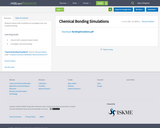
Students interact with simulations to investigate ionic and covalent bonding.
- Subject:
- Chemistry
- Physical Science
- Material Type:
- Homework/Assignment
- Date Added:
- 12/12/2018

Students interact with simulations to investigate ionic and covalent bonding.
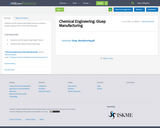
Students use the engineering design process to prepare a sample of gluep that can best meet their goal.

The use of a salt water tank for ion testing pairs nicely with the electron and flame test unit in chemistry.
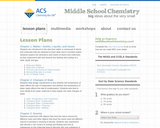
This site contains 6 lessons: Chapter 1: Matter—Solids, Liquids, and Gases, Chapter 2: Changes of State, Chapter 3: Density, Chapter 4: The Periodic Table & Bonding, Chapter 5: The Water Molecule and Dissolving, Chapter 6: Chemical Change. Each lesson has chapter reading, videos, teacher lesson pages, student activity sheets, activity answer sheets, explore activities, downloadable lessons. Everything you need for each of these topics. Each chapter has multiple lessons breaking down the content.
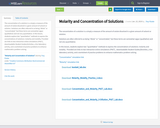
The concentration of a solution is a simply a measure of the amount of solute dissolved in a given amount of solvent or solution.
Solutions are often referred to as being “dilute” or “concentrated,” but these terms are somewhat vague (qualitative) and not very quantitative.
In this lesson, students explore two "quantitative" methods to express the concentrations of solutions: molarity and molality. Provided are links to two interactive online simulations (PhET), downloadable Student Guides/Activities, a fun laboratory activity, and a worksheet of practice problems to enhance mathematics problem solving.
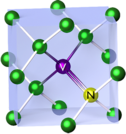
Chemistry lesson activities involving VSEPR and electron transitions. This apply directly to quantum physics.

These are source data and an article from the Journal "Nature" to use with students for anchoring the effects of Global Climate change on ice durations of local lakes. The article describes ice conditions and methadologies of 6 Wisconsin Lakes. There are links to raw data that can be used to generate graphs and develop sensemaking for students.

this is a physics activity that starts with information about heat transfer and then leads into an engineering challenge involving creating a heat shield to protect a glue joint